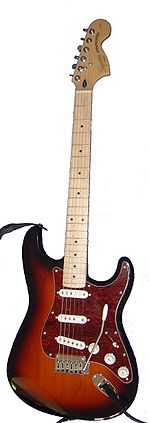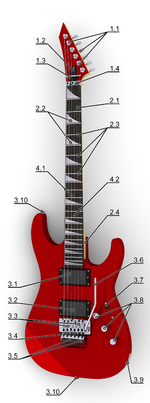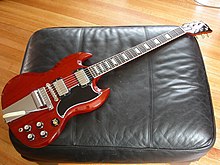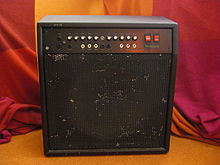Electric guitar
| Electric guitar (electric guitar) | |
|---|---|
| english: electric guitar , italian: chitarra elettrica , french: guitare électrique | |
| Six-string Squier Stratocaster | |
| classification |
Chordophone ( electrophone ) plucked instrument |
| range |

|
| Musician | |
|
List of guitarists Category: Guitarist |
|
An electric guitar (also known as an electric guitar , electric guitar, or electric guitar ) is a guitar designed for electric pickup . In contrast to the acoustic guitar, it does not primarily rely on an acoustic body to amplify the string vibrations . This means that other designs can be achieved, which give many electric guitars, among other things, particularly easy playability. Another advantage is the variety of sounds that can be generated using guitar amplifiers and effects devices.
The development of the electric guitar was driven by the desire to give the instrument a higher volume. This became necessary because the guitarists in jazz with purely acoustic instruments could hardly prevail against wind instruments or even a single piano. So the electric guitar gradually developed from the well-known acoustic guitar. That is why the term electric guitar in the broader sense covers the entire range of acoustic (jazz) guitars with built-in pickups on the one hand and guitars without a resonance body on the other. Between these two extremes there are numerous mixed forms that have persisted to this day and which are mostly referred to as "semi-acoustic" electric guitars or semi-resonance guitars (e.g. Gibson ES-335).
construction
|
The body of an electric guitar is usually made of solid wood ( solidbody ). Other materials, such as different plastics , which can also be reinforced with carbon fibers , are rarely used . But there are also electric guitars with a hollow body similar to the acoustic guitar as well as mixed forms ( semi-resonance guitar , "semi-acoustic"). The material used, the nature of the material and the shape of the sound body, unlike the pickups and their circuitry, play only a minor role in the sound of the electric guitar.

There are also various forms of constructional details that have a massive influence on the sound of the guitar. So is z. B. to differentiate between different methods of connecting the neck to the body. The most common methods are screwing and gluing. When screwing, the neck is embedded in a corresponding milling of the body and connected to the body with usually four wooden screws guided through a metal base plate . However, there are also constructions with three or five screws and with individual washers or sleeves. When gluing , the neck is usually inserted much further into the body and firmly glued to it. In some models, the neck also consists of a continuous block and only the body halves are glued on.
Even with the hardware used (see mechanics ), e.g. B. the tuning mechanisms or the bridge (specifically called the bridge on the electric guitar), there are very different characteristics that affect the sound of the instrument through the construction and material used.
An electric guitar usually has six strings , but there are also models with seven , eight (e.g. Ibanez RG-2228 GK ), nine and twelve strings. Another shape is an electric guitar with two necks with six strings each or with six and twelve strings.
Electric guitars usually have 21, 22 or (as a "double-octave") 24 frets , which help to shorten the string when fingering in order to produce a specific note when struck. Each fret corresponds to a semitone step . There are also special designs with up to 36 frets ( KK Downing , Judas Priest ). There are different neck lengths and widths, the scale length is usually 628 mm (Gibson Les Paul) or 648 mm (Fender Stratocaster).
The frequency range of the fundamental tones of a six-string, 24-fret guitar in the standard EAdgh-e 'tuning extends from 82.4 to 1318.5 Hz . There are also other guitar tunings that adapt the instrument for different tasks.
Electrics

The string vibrations to electric guitars are electromagnetic pickups ( English : pickup ) removed and electronically amplified reproduced. When it comes to pickups, a distinction is essentially made between single coil and humbuckers .
The principle of picking up electrical signals that has prevailed to this day goes back to the 1930s: permanent magnets are mounted directly below the vibrating steel alloy strings. These are wound with a coil . Vibrations of the strings lead to disturbances of the magnetic field, which in turn cause an electrical alternating voltage in the coil through induction . This weak signal is fed to an amplifier. In this respect, an electric guitar is an electric, but not an electronic musical instrument. Vibrations that run through the body material and the neck in turn influence the vibration of the string, so the wood (or possibly other material) also has a certain influence on the sound.
In order to vary the sound, many electric guitars have several pickups and selector switches to switch between them and also to create combinations between the individual pickups. The pickups can often also be influenced by a potentiometer and a height adjuster, the tone potentiometer, in terms of the voltage to be output and thus the output volume. With the vast majority of electric guitars, especially with high-quality branded products, the possibilities of influencing the sound are extremely limited. In fact, only the tone control regulates the effect of a capacitor connected in parallel to the pickup , which means that more or less high frequencies can be removed from the sound - the guitar sounds duller depending on the setting. Active tone controls offer more possibilities, with which the variety of sounds of the instrument can be increased. Active pickups are said to have both the positive and negative sound properties mentioned - for example, that they sound sterile without distortion. A disadvantage of active electronics is that the guitar requires its own voltage source (usually a battery). Some models are also equipped with piezo pickups to mimic the sound of an acoustic guitar; for example, since the early 1990s, most models from the US manufacturer Parker Guitars .
Since the introduction of the MIDI standard in the mid-1980s, systems have been developed with which the individual string vibrations of a guitar are converted into MIDI signals in real time . This “MIDIfication” of the guitar signals makes it possible to control sound generators that can process MIDI commands. A guitar can play sounds from synthesizers , drum computers or samplers . In contrast to the guitar synthesizer , the audio signal from the pickup is not used to generate the sound.
There are also so-called modeling guitars, in which the vibration of the strings is recorded by a piezo pickup and the sound of various guitar models is imitated by means of a computer. The company Line 6 , which also builds modeling amplifiers, is a pioneer and currently the leader of this technology.
Types
The electric guitar has three basic types, these differ most noticeably in their construction: There are guitars with a cavity, which, depending on the height of the sides (side walls), are referred to as half or full resonance guitars, and so-called solid bodies , which consist of one or several solid wooden blocks glued together.
The most famous and widely used electric guitars are the Stratocaster (1954) from Fender and the Gibson Les Paul (1952) from Gibson . Other models are the Fender Telecaster (1950) and the Gibson SG (1961). All of these models are made to this day.
The Fender Stratocaster has two cutaways , i.e. indentations at the base of the neck of the body, which should enable the higher register to be played, and three single-coil pickups. The Gibson Les Paul has only one cutaway and is equipped with two humbucking pickups. In addition to the different pickups, fundamental differences in construction and choice of wood also ensure that these models also differ significantly in their sound. The Les Paul produces a warm, full tone, while the Stratocaster produces a sharper, more transparent tone.
There are other designs and electric guitars with special shapes tailored to the music style (e.g. the Flying V in the shape of an arrow, the Gibson Explorer , Jackson “ Randy Rhoads ” or the even more extreme models from BC Rich ). Roughly, however, most - including newer - models refer to the classic construction methods of the Stratocaster or Les Paul.
mechanics

Tuning mechanics or simply mechanics are the rotatable elements on the head of the guitar with which the strings are "wound" and tuned (see also pegs ). The mechanics of electric guitars (and western guitars) are preferably made of metal because of the strong tension of the steel strings - in contrast to classic concert guitars with nylon strings. For guitar models with a headstock in “Stratocaster” style, all elements are arranged one behind the other on one side of the headstock. This arrangement is made possible by the inclined shape of the head and - viewed from the front - causes the strings to be straight, which in principle has less of a tendency to become detuned. Most of the time, string hold-down devices are required for the high strings so that the strings have a certain contact pressure on the saddle. As with acoustic guitars, “Les Paul” -style guitars have three elements on each side. The headstock is usually angled backwards and the strings are angled backwards and to the side from the saddle to the machine heads. With some guitar models - such as B. from the companies Paul Reed Smith or MusicMan - there are also modifications or mixed forms of these two designs. Well-known manufacturers of mechanics are z. B. Schaller , Grover, Kluson and Gotoh.
tremolo
→ Main article: tremolo
Many types of electric guitars have a mechanical device for pitch variation (vibrato), which - strictly speaking incorrectly - is known as a tremolo (actually volume variation). Depending on the type of guitar, there are different tremolo systems (e.g. Bigsby or Floyd Rose ). The pitch changes are made possible by the slackening or tensioning of the strings, which is controlled by a lever (colloquially "whammy bar" or "whammy hook") on the bridge . The strings are temporarily detuned in a controlled manner, so to speak.
amplifier
Main article: Guitar amplifier
On closer inspection, the electric guitar as a musical instrument consists of the actual instrument and the guitar amplifier , as this plays a significant role in shaping the sound. Striking is the basis of the sound that when overdriving of tube amplifiers is generated. The tubes , which are driven into overdrive, produce a singing, lively tone that has shaped modern popular music. Overdrive (or distortion) was seen as an undesirable effect in the early days of electric guitar amplifiers. The manufacturers therefore tried by all means to avoid overdriving in order to comply with the undistorted ideal of the guitar tone that prevailed at the time. In those days, distortion could only be achieved by operating amplifiers under full load (output stage distortion). It's hard to tell today whether guitarists purposely played louder to get distortion, or whether they discovered the benefits of a distorted tone because they had to play louder. The fact is that the new sound prevailed and the manufacturers of guitar amplifiers also responded to the new demand, above all the British manufacturer Marshall , by enabling overdrive in the preamplifier stage. This made distortion possible even at lower volumes. Both types of overdrive (pre- or output stage overdrive) have different effects on the guitar tone. Because of the advantages of the dynamically acting output stage overdrive, there are still guitarists today who play with the amplifiers fully turned up. Since the 1960s there have been semiconductor- based effect devices ( distortion devices ) that emulate the sound of overdriven electron tubes. Nevertheless, the camp of purists has prevailed so far, according to whose opinion a “real” all-tube amplifier has not yet been surpassed in musical performance. The fact that a relatively large number of semiconductor-based guitar amplifiers are still sold is due to the lower costs of this design. In recent years, more and more “ digital ” guitar amplifiers have been developed that generate the sound using a digital signal processor and software . This makes it possible to realize the sound of many guitar amplifiers with a single device ("Amp Modeling") and to combine virtual effect devices as desired.
A contrary trend in the guitarist scene arises from many new companies that manufacture all-tube amplifiers in small numbers and often handcrafted. These amplifiers are often offered with rather low power (1 watt, 6 watt, 15 watt) in order to achieve the "real" sound of an all-tube amplifier even at lower volumes. They are usually very simple in design, but allow a great variety of sounds, as they enable the operation of different tube types, with which they are able to produce the sound characteristics of a wide variety of models (e.g. so-called "British Sound" with EL34 types (Marshall) or EL84 ( Vox ) or "American Sound" with 6L6 tubes (Fender)).
Guitar effects
Main article: Guitar effects
Guitar effects are usually understood as the effect of electronic circuits that change the guitar signal. Some of them are integrated into the amplifiers. Often they also appear in the form of so-called "floor kicks" or pedals, but complex 19 "effect processors are also used here. In addition to effects influencing volume (booster) and frequency response ( equalizer ), non-linear distortion effects such as overdrive , fuzz or distortion , others such as reverberation , sustain or echo , and modulation effects such as wah-wah , chorus , flanger , vibrato or phaser are used here and many more. From the late 1960s onwards, guitar signals were also often modulated by analog synthesizers . Examples are the Moog synthesizer or devices from KORG or Oberheim .
In addition to the exclusively electronically generated effects, devices are also used that make the steel strings of the guitar vibrate with electromagnetic actuators . This allows the string oscillation to be extended up to continuous oscillation, which is why such devices are called sustainers. Another effect is the targeted amplification of the overtones of the string oscillation.
There are three versions: Fernandes Sustainer and Sustainiac are built into the guitar. The E-Bow is held in the hand. There is also a fixed version on a microphone stand (Vibesware Guitar Resonator ).
history
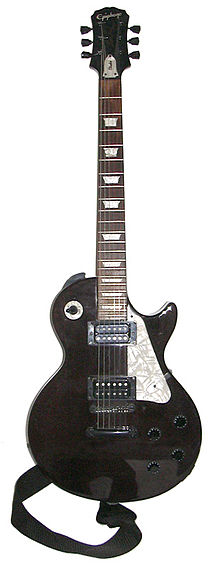
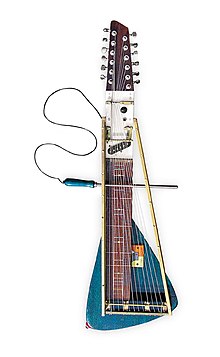
The development of the electric guitar began around 1920 when people were looking for ways to make the guitar louder and more assertive as an instrument in music groups. Due to its low volume compared to wind instruments, the guitar was determined to play a role as a pure rhythm instrument in larger music groups. The era of large entertainment orchestras and big bands , as well as the recording technology of that time, challenged the instrument makers to build louder guitars with a larger sound volume. The first methods of achieving this were to enlarge the body of acoustic instruments and, in the 1920s, to develop the resonator guitar . By around 1930 it had been found that the only way to achieve the goal was to electrically amplify the sound. But this method also had opponents who prophesied that music would go into neglect. The electric guitars first found their way into country , jazz , and blues .
As early as 1923, Lloyd Loar , who had been a senior engineer in Gibson's development department since 1919, was experimenting with the first electric pickups . He invented a sensor that could pick up the vibrations of the top of a stringed instrument and convert it into an electrical signal. This pickup was first tested by Loar with a double bass . Since these sensors were impractical to use and the Gibson management was skeptical or even negative about this development, they could not establish themselves on the market.
In 1931, George Beauchamp and Adolph Rickenbacher (later Adolph Rickenbacker, founder of the Rickenbacker company ) developed a pickup that made direct use of the vibrations of steel strings. This pickup was based on the principle of induction: a coil was wound around a magnetic core. If the metal strings now moved in the field of this magnet, it was changed, which induced a voltage in the coil. The basic principle on which today's pickups are based was invented. At first the pickup consisted of two horseshoe magnets through which the strings were passed. Rickenbacker built it into a lap steel guitar that was made from a single piece of wood. Because of its characteristic shape with a small, circular body, it was called Rickenbacker Frying Pan ("Rickenbacker frying pan"). Later versions of this guitar were even made entirely of aluminum. The US patent for his musical frying pan was submitted by Beauchamp in 1932, the second for a revised version was filed in 1934. Although the guitar was already successfully on the market, the patent office asked whether the device could be used at all. To prove this, Adolph Rickenbacker sent several guitarists to the responsible patent office in Washington DC to serenade the clerks. After a long delay, he received the patent in 1937. In the meantime, other manufacturers had also developed electric guitars.
The first guitar model to be played regularly was the Electro Spanish, also introduced by Rickenbacker in 1932 . The instrument had the same pickup as the "Frying Pan". Nothing is known about the market success of this model. The first commercially successful guitar model with an electric pickup in series production was the Gibson ES-150, presented in 1936, which also incorporated the experience of the guitarist Alvino Rey . In principle, the ES-150 was a jazz guitar with a pickup embedded in the ceiling. "ES" stands for E lectric S Panish and was not so much related to the relationship with the classic "Spanish" guitar, but on the fretted play as opposed to lap steel guitar. The number "150" stood for the then official retail price of 150 dollars including guitar amplifier and cable. In Germany in the 1940s, the guitar makers Wenzel and Roger Rossmeisl were among the pioneers in the field of electrified jazz and Hawaiian guitars.
In 1941, Lester William Polfus (alias Les Paul) took a further step towards modern electric guitars: he sawed the body of an acoustic guitar lengthwise in two and inserted a solid block of wood in the middle. This instrument was named " The Log " ("the block"). It was only a small step from this instrument to the solid body guitars with a solid body. With these, the often annoying feedback from previous electric guitars was reduced. In addition, a longer lasting oscillation ( sustain ) of the strings was achieved.
The first electric guitar with a partially solid body was made by Paul Bigsby in 1948 at the suggestion of country musician Merle Travis . This Bigsby / Travis guitar had a single coil pickup in the bridge position, a continuous neck and a headstock with six machine heads mounted in series. Bigsby, who made a name for himself in particular with his vibrato systems, produced various versions of this guitar in small numbers up until the 1960s.
Inspired by Bigsby / Travis Guitar, Leo Fender brought his first electric guitar onto the market in 1950 under the name Esquire , still with just a pick-up and without a neck tensioning rod . This instrument, called Telecaster after several name changes, was the first mass- produced electric guitar. The first Esquire models did not have a truss rod, which bent the neck because the strings developed a certain amount of tension. The neck was easy to exchange, but this concept was unsuccessful and so Leo Fender finally built in truss rods and from the end of 1950 sold the now called "Broadcaster" guitar with a second pick-up. After a legal dispute with Gretsch for a short time without a name (Nocaster) and finally called Fender Telecaster from summer 1951, it has been available as an original and as a copy from a now unmanageable number of other manufacturers.
The Stratocaster , launched by Fender in 1954, was one of the first guitars to feature a tremolo arm . Due to a confusion of the name and meaning of vibrato and tremolo by Leo Fender , the system originally intended for vibratos was registered for a patent on April 10, 1956 under the name Synchronized tremolo .
Ibanez and Steve Vai developed a seven-string electric guitar (Universe) in 1987, which came on the market in 1990. The guitar, which was initially provided with a high A-string, later paved the way for Nu-Metal with a low B-string. In 2003, Line 6 launched the Variax , an electric guitar that simulates various well-known electric guitar models and acoustic guitars for the first time. Today there are the most unusual versions of electric guitars, such as electric guitars with two necks or a guitar that contains the range of the electric bass and electric guitar in one instrument and the electric guitar has been around since 2007 himself agrees.
Pioneering guitarists
People are named here who have shaped and promoted the electric guitar in a technical or playful sense through developments or personal work.
- From 1936 onwards, Charlie Christian was largely responsible for the further development of the electric guitar from a pure accompanying instrument to a full-fledged solo instrument through his solo and melody playing in Benny Goodman's bands .
- Lester William Polfus aka Les Paul was a pioneer in the development of solid body electric guitars and modern recording techniques .
- Leo Fender developed in the early 1950s after he named electric guitars and basses with solid body (solid body) and is one of the pioneers in the history of guitar construction.
- Muddy Waters established the electric guitar as the dominant instrument in the Chicago blues in the late 1940s .
- BB King , was one of the last Afro-American blues legends, influenced Eric Clapton and Angus Young , among others .
- Chuck Berry created some of the most famous guitar riffs in rock music (for example, Roll Over Beethoven and Johnny B. Goode ).
- Jimi Hendrix developed the playing technique in a variety of ways and also used feedback . He was the first to play the combination of Fender Stratocaster and Marshall amplifier, which has become legendary for its classic rock sound.
- Jimmy Page ( ex-Yardbirds ), from Led Zeppelin, paved the way for rock music with pieces like Stairway to Heaven and Whole Lotta Love . He used different string tunings or a violin bow for sound experiments.
- Eric Clapton ( ex-Yardbirds ) is known for his slow vibrato
- Jeff Beck ( Ex-Yardbirds ) aka "The Strat Cat". He is known for experimental play, especially with the tremolo arm, and received a Grammy for, among other things, “Best Rock Instrumental Performance”.
- Pete Townshend ( The Who ) experimented with feedback, made the power chord socially acceptable and developed the Marshall stack in collaboration with Jim Marshall .
- Keith Richards often uses open moods . The open G tuning , in which Richards' guitar is only strung with five strings (he does without the low E string), has become one of his trademarks. Because of his distinctive guitar riffs in this mood, Richards is nicknamed "The Human Riff" among colleagues.
- Duane Allman ( Allman Brothers ) put on a wide variety of slide guitar licks on the live album At Fillmore East .
- Rory Gallagher (ex-The Taste) stood out in the 1970s for his playing with the bottleneck and for his slide solos.
- Peter Frampton through his innovative use of the talk box (for example in the song Show Me the Way ).
- Brian May ( Queen ) built his guitar known as the Red Special together with his father in the 1960s . He used, for example, the blade of a bread knife, wood from an old fireplace, knitting needles and motorcycle valve springs. The Red Special is still his main guitar today, but now he occasionally plays on replicas of this instrument.
- David Gilmour ( Pink Floyd ) is known for his clear sounds, bending and the targeted use of delay .
- Mark Knopfler created an unmistakable timbre with his fingerstyle , often turning up the volume control of his guitar only after the string was struck (which makes the sound seem to come out of nowhere) and composed guitar riffs like in Money for Nothing ( Dire Straits ).
- Edward Van Halen ( Van Halen ) made tapping popular. He was one of the first to build a clamping saddle ( locking system) on the headstock of his Stratocaster. The D-Tuner on the Floyd Rose tremolos is considered his development. His modifications to pickups are also known, such as an immersion bath in hot wax to reduce microphony .
- Joe Satriani has received several Grammy nominations for almost exclusively instrumental music and has sold several million albums and is one of the most influential contemporary guitarists thanks to his outstanding playing technique.
- Steve Vai developed the Ibanez Universe, the first seven-string guitar that was mass-produced. In addition, the JEM series he developed has also been in Ibanez's repertoire since 1987. Vai also worked with other companies to develop pickups, amplifiers and wah-wah pedals based on his own ideas.
literature
- Tony Bacon: guitar classics. All models and manufacturers. Premio, Münster 2007, ISBN 978-3-86706-050-9 .
- Christoph Reiss: Guitar Recording. Wizoo Publishing, Bremen 2010, ISBN 978-3-934903-75-3 (with CD).
- John Schneider : The Contemporary Guitar (= The new Instrumentation. Vol. 5). University of California Press, Berkeley CA et al. a. 1985, ISBN 0-520-04048-1 (comprehensive description of acoustic and electric guitar, including notation, playing techniques, and repertoire; relates primarily to new music ).
- Helmuth Lemme: Pickups, Potis & Co - The inner workings of the electric guitar and bass. PPVMEDIEN, Bergkirchen 2018, ISBN 978-3-95512-121-1 .
- Manfred Zollner: Physics of the electric guitar . (Research documentation, PDF download possible).
Web links
- Electric guitar
- Electric guitar dictionary
- Electric guitar - know-how, tips and tricks
- Guitar effects
Individual evidence
- ↑ Electric guitar - functionality and sound generation of an electric guitar, pickup / pickup etc. Accessed on January 18, 2019 .
- ^ Tony Bacon, Paul Day: The Ultimate Guitar Book. Edited by Nigel Osborne, Dorling Kindersley, London / New York / Stuttgart 1991; Reprint 1993, ISBN 0-86318-640-8 , p. 118 f.
- ↑ Frequency tables guitar and bass (PDF; 178 kB)
- ↑ Bacon: Guitar Classics. 2007, p. 48 f.
- ↑ Bacon: Guitar Classics. 2007, p. 57.
- ↑ a b Bacon: Guitar Classics. 2007, p. 54 f.
- ↑ Bacon: Guitar Classics. 2007, p. 56 f.
- ↑ Bacon: Guitar Classics. 2007, p. 58 f.
- ↑ Bacon: Guitar Classics. 2007, p. 60 f.
- ↑ gibson.com ( Memento from July 10, 2013 in the Internet Archive )
